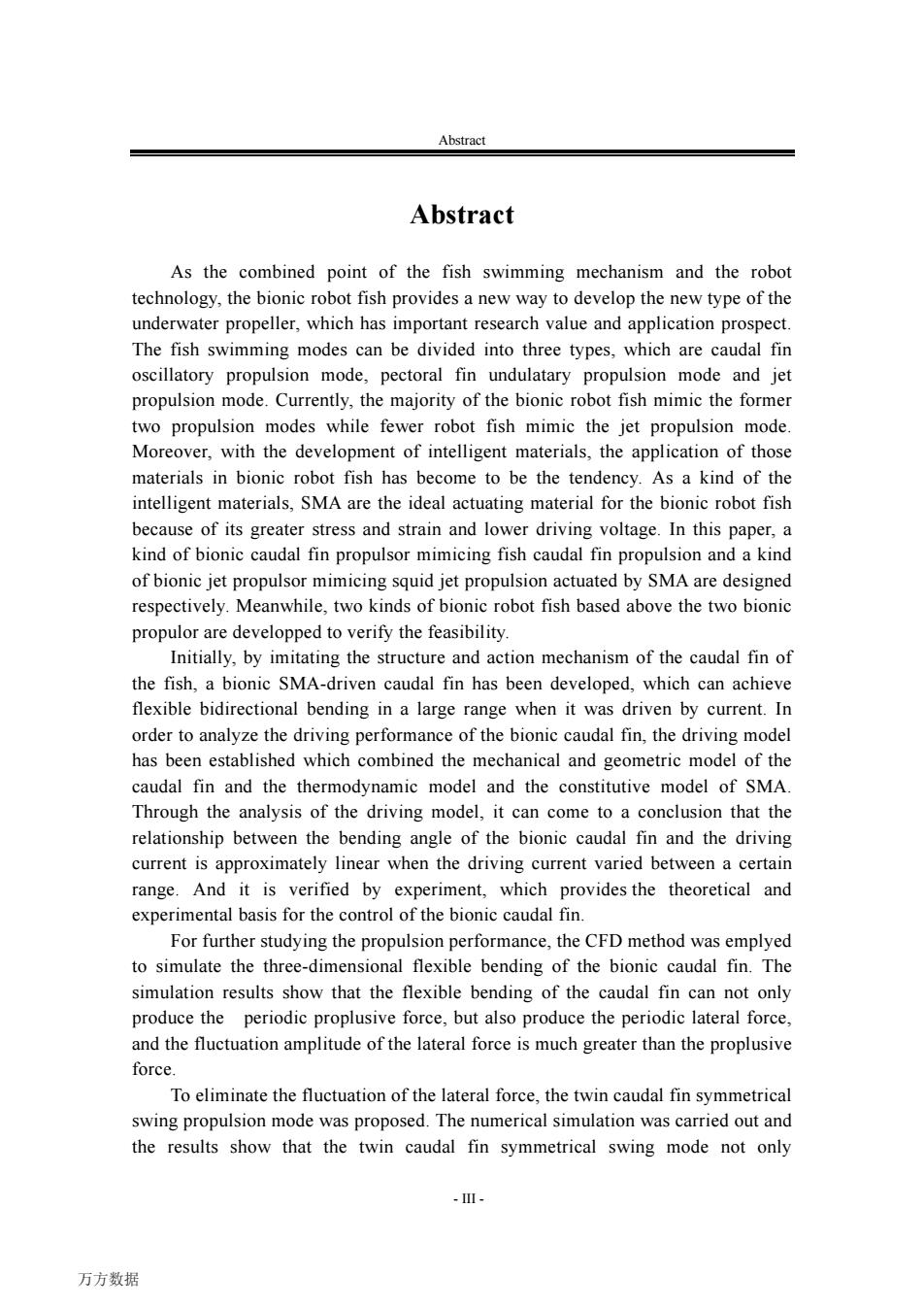正在加载图片...

Abstract Abstract As the combined point of the fish swimming mechanism and the robot technology,the bionic robot fish provides a new way to develop the new type of the underwater propeller,which has important research value and application prospect. The fish swimming modes can be divided into three types,which are caudal fin oscillatory propulsion mode,pectoral fin undulatary propulsion mode and jet propulsion mode.Currently,the majority of the bionic robot fish mimic the former two propulsion modes while fewer robot fish mimic the jet propulsion mode Moreover,with the development of intelligent materials,the application of those materials in bionic robot fish has become to be the tendency.As a kind of the intelligent materials,SMA are the ideal actuating material for the bionic robot fish because of its greater stress and strain and lower driving voltage.In this paper,a kind of bionic caudal fin propulsor mimicing fish caudal fin propulsion and a kind of bionic jet propulsor mimicing squid jet propulsion actuated by SMA are designed respectively.Meanwhile,two kinds of bionic robot fish based above the two bionic propulor are developped to verify the feasibility. Initially,by imitating the structure and action mechanism of the caudal fin of the fish,a bionic SMA-driven caudal fin has been developed,which can achieve flexible bidirectional bending in a large range when it was driven by current.In order to analyze the driving performance of the bionic caudal fin,the driving model has been established which combined the mechanical and geometric model of the caudal fin and the thermodynamic model and the constitutive model of SMA. Through the analysis of the driving model,it can come to a conclusion that the relationship between the bending angle of the bionic caudal fin and the driving current is approximately linear when the driving current varied between a certain range.And it is verified by experiment,which provides the theoretical and experimental basis for the control of the bionic caudal fin. For further studying the propulsion performance,the CFD method was emplyed to simulate the three-dimensional flexible bending of the bionic caudal fin.The simulation results show that the flexible bending of the caudal fin can not only produce the periodic proplusive force,but also produce the periodic lateral force, and the fluctuation amplitude of the lateral force is much greater than the proplusive force. To eliminate the fluctuation of the lateral force,the twin caudal fin symmetrical swing propulsion mode was proposed.The numerical simulation was carried out and the results show that the twin caudal fin symmetrical swing mode not only -I- 万方数据Abstract - III - Abstract As the combined point of the fish swimming mechanism and the robot technology, the bionic robot fish provides a new way to develop the new type of the underwater propeller, which has important research value and application prospect. The fish swimming modes can be divided into three types, which are caudal fin oscillatory propulsion mode, pectoral fin undulatary propulsion mode and jet propulsion mode. Currently, the majority of the bionic robot fish mimic the former two propulsion modes while fewer robot fish mimic the jet propulsion mode. Moreover, with the development of intelligent materials, the application of those materials in bionic robot fish has become to be the tendency. As a kind of the intelligent materials, SMA are the ideal actuating material for the bionic robot fish because of its greater stress and strain and lower driving voltage. In this paper, a kind of bionic caudal fin propulsor mimicing fish caudal fin propulsion and a kind of bionic jet propulsor mimicing squid jet propulsion actuated by SMA are designed respectively. Meanwhile, two kinds of bionic robot fish based above the two bionic propulor are developped to verify the feasibility. Initially, by imitating the structure and action mechanism of the caudal fin of the fish, a bionic SMA-driven caudal fin has been developed, which can achieve flexible bidirectional bending in a large range when it was driven by current. In order to analyze the driving performance of the bionic caudal fin, the driving model has been established which combined the mechanical and geometric model of the caudal fin and the thermodynamic model and the constitutive model of SMA. Through the analysis of the driving model, it can come to a conclusion that the relationship between the bending angle of the bionic caudal fin and the driving current is approximately linear when the driving current varied between a certain range. And it is verified by experiment, which provides the theoretical and experimental basis for the control of the bionic caudal fin. For further studying the propulsion performance, the CFD method was emplyed to simulate the three-dimensional flexible bending of the bionic caudal fin. The simulation results show that the flexible bending of the caudal fin can not only produce the periodic proplusive force, but also produce the periodic lateral force, and the fluctuation amplitude of the lateral force is much greater than the proplusive force. To eliminate the fluctuation of the lateral force, the twin caudal fin symmetrical swing propulsion mode was proposed. The numerical simulation was carried out and the results show that the twin caudal fin symmetrical swing mode not only 万方数据